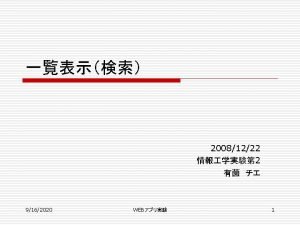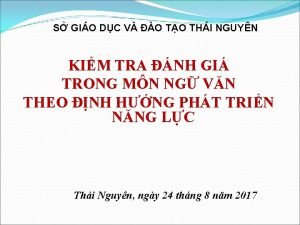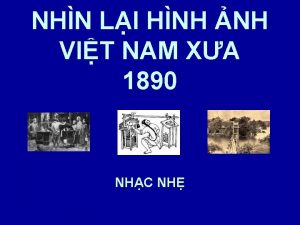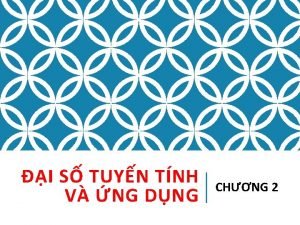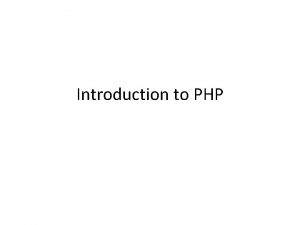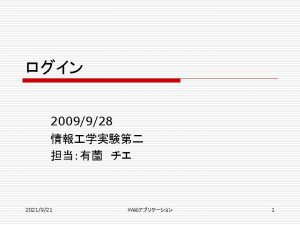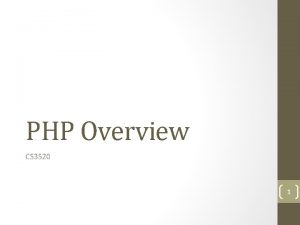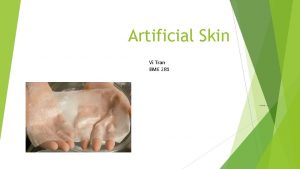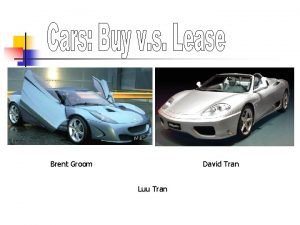NG PHP N NG CAO Teacher Ms Tran




















- Slides: 20

NGỮ PHÁP N NG CAO Teacher: Ms. Tran Thi Le Anh Class: MH 310709901, MH 310709902 On Thursday morning Email: tranthileanh@hotec. edu. vn Phone: 0979479775 Sinh viên nộp bài tập (exercise) qua email hoặc zalo dưới tập file word: tên lớp học. tên sinh viên. bài học. docx trước ngày 1/5/2020 • Vd: MH 310709901. nguyenvan. A. units 81 -84. docx • • •

Part 1: Lessons Units 81 -84 PASSIVE

What is this? This is an apple. the world’s favorite fruit

What do you know about apples? • 1/ More than 50 million tons of apples are grown every year. • 2/ The first apples were grown in central Asia. • 3/ The first apple tree was brought to Europe by Alexander the Great. • 4/ Apples were introduced to the Americas by Europeans in the 1600 s. • 5/ Today, most apples are produced in China. • 6/ Apples aren’t usually found in tropical countries.

Passives • The above underlined verbs are in passive voice: be + past participle (p. p) • Ex: Most apples are produced in China. • S be p. p • You can use the passive to talk about facts and processes.

Passive voice • The passive focuses attention on an action or the object of the action. The object of the action becomes the subject of the verb.

Passive of present simple and past simple 1/ Simple present: • (+): S + is/are + p. p • (-): S + isn’t / aren’t + p. p • (? ): Is/Are + S + p. p? 2/ Simple past: • (+): S + was/were +p. p • (-): S + wasn’t / weren’t + p. p • (? ): Was/ Were + S + p. p?

Passive of present continuous and past continuous 1/ Present continuous: • (+): S + is/are + being + p. p • (-): S + isn’t /aren’t + being +p. p • (? ): Is/Are + S + being + p. p? 2/ Past continuous: • (+): S + was/were +being +p. p • (-): S + wasn’t / weren’t + being +p. p • (? ): Was/ Were + S + being + p. p?

Passive of present perfect and past perfect 1/ Present perfect: • (+): S + has/have + been + p. p • (-): S + hasn’t/haven’t + been + p. p • (? ): Has/Have + S + been + p. p? 2/ Past perfect: • (+): S + had + been + p. p • (-): S + hadn’t + been + p. p • (? ): Had + S + been + p. p?

Passive of simple future and be going to 1/ Simple future: • (+): S + will + be + p. p • (-): S + won’t + be + p. p • (? ): Will + S + be + p. p? 2/ be going to: • (+): S + is/are going to + be + p. p • (-): S + isn’t /aren’t going to + be + p. p • (? ): Is/Are + S + going to + be + p. p?

Passive of modal verbs Modal verbs: can/could, should, must, may/might … • (+): S + can/ should …+ be + p. p • (-): S + can’t/ shouldn’t … + be + p. p • (? ): Can/Should …+ S + be + p. p?

By + O (object) • When you want to say who or what was responsible for the action (the subject or agent of the action) you use by: • Ex: Apples were introduced to the Americas by Europeans in the 1600 s. • You may not want to say who or what did the action. • You can also say: Ex: Apples were introduced to the Americas in the 1600 s. • You don’t normally use by when the agent is. . . • obvious and therefore unnecessary: Ex: The first apples were grown in central Asia by Asian farmers. • unknown: Ex: An apple was left on my desk. (I don’t know who left it there. )

Passive or Active • In a sentence with an active verb, the subject of the verb is the person or thing responsible for the action: Ex: We are building a second bridge across the bay. • In a sentence with a passive verb, the subject of the verb is the object of the action: Ex: A new bridge is going to be built across the bay. • The choice between active and passive depends on what or who you want to focus on. Ex: The bridge was designed by a local architect. (You are focusing attention on the bridge. ) Ex: A local architect designed the bridge. (You are focusing attention on the architect. )

Verbs with two objects • Buy, give, explain, lend, make, offer, pay, promise, refuse, send, show, teach, appoint…can have two objects Ex: He gave the children three apples. • Indirect object Direct object • IO DO Ex: He gave three apples to the children. • Direct object Indirect object • Therefore, two passives are possible: Ex: The children were given three apples. • IO + be + p. p + DO Ex: Three apples were given to the children. • DO + be + p. p + to + IO

Passive: Verbs with two objects DO + be + p. p + prep + IO IO + be + p. p + DO • either with the direct object (DO) of the action as the subject of the passive verb: Ex: Gold medals were given to the girls. A prize of £ 1, 000 was awarded to the school. • or with the indirect object (IO) of the action as the subject of the passive verb: Ex: The girls were given gold medals. The school was awarded a prize of £ 1, 000.

Use of prepositions • When the passive sentence starts with the direct object of the action, you use a preposition with the indirect object:

Don’t use prepositions • When the passive sentence starts with the indirect object of the action, you don’t need a preposition:

Causative form (Thể sai khiến) • Use have/ get+ object + past participle to talk about things other people do for you: Ex: I got/ had my hair cut at the salon across the road. Active: S + have + O (person) + bare infinitive + O (thing) S + get + O (person) + to-infinitive + O (thing) Passive: S + have /get + O (thing) + p. p

You can use have/ get something done in a variety of tenses: I (don’t) get / have my hair cut very often. Where do you get/ have your hair cut? I’m having my car repaired today. I’ll get my suit cleaned tomorrow. Have you had your ears pierced? The neighbors haven't had their house painted for ages. Note: Get something done is more informal than have something done. • • •

Part 2: Exercises Units 81 -84 PASSIVE
 Cao đẳng nghề trần hưng đạo
Cao đẳng nghề trần hưng đạo Which color signifies fierceness
Which color signifies fierceness Web.facebook.com.php
Web.facebook.com.php Php php://input
Php php://input Erf process
Erf process Good afternoon teacher.
Good afternoon teacher. Tran van cam
Tran van cam Remi tran
Remi tran Ma trận bcg của biti's
Ma trận bcg của biti's Googlel tran
Googlel tran Md trần trác
Md trần trác Kĩ thuật rubric trong môn ngữ văn
Kĩ thuật rubric trong môn ngữ văn Giám khảo trần sĩ trác
Giám khảo trần sĩ trác Công thức tính ma trận nghịch đảo
Công thức tính ma trận nghịch đảo Mri energy consumption
Mri energy consumption Alleluia hat len nguoi oi
Alleluia hat len nguoi oi Leana tran
Leana tran Ku credtran
Ku credtran 3 gio
3 gio Sabrina tran
Sabrina tran ông trời mặc áo giáp đen ra trận
ông trời mặc áo giáp đen ra trận



